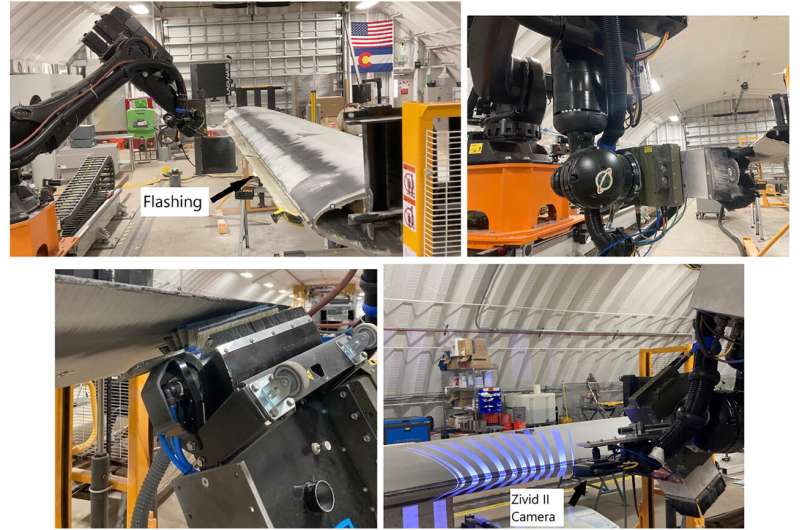This article has been reviewed according to Science X's editorial process and policies. Editors have highlighted the following attributes while ensuring the content's credibility:
fact-checked
trusted source
proofread
Leveraging robots to help make wind turbine blades

Researchers at the U.S. Department of Energy's National Renewable Energy Laboratory (NREL) have successfully leveraged robotic assistance in the manufacture of wind turbine blades, allowing for the elimination of difficult working conditions for humans and the potential to improve the consistency of the product.
Although robots have been used by the wind energy industry to paint and polish blades, automation has not been widely adopted. Research at the laboratory demonstrates the ability of a robot to trim, grind, and sand blades. Those necessary steps occur after the two sides of the blade are made using a mold and then bonded together.
"I would consider it a success," said Hunter Huth, a robotics engineer at NREL and lead author of a newly published paper detailing the work. "Not everything operated as well as we wanted it to, but we learned all the lessons we think we need to make it meet or exceed our expectations."
The paper, "Toolpath Generation for Automated Wind Turbine Blade Finishing Operations," appears in the journal Wind Energy. The co-authors, all from NREL, are Casey Nichols, Scott Lambert, Petr Sindler, Derek Berry, David Barnes, Ryan Beach, and David Snowberg.
The post-molding operations to manufacture wind turbine blades require workers to perch on scaffolding and wear protective suits, including respiratory gear. Automation, the researchers noted, will boost employee safety and well-being and help manufacturers retain skilled labor.
"This work is critical to enable significant U.S.-based blade manufacturing for the domestic wind turbine market," said Daniel Laird, director of the National Wind Technology Center at NREL. "Though it may not be obvious, automating some of the labor in blade manufacture can lead to more U.S. jobs because it improves the economics of domestic blades versus imported blades."
"The motive of this research was to develop automation methods that could be used to make domestically manufactured blades cost-competitive globally," Huth said. "Currently, offshore blades are not produced in the U.S. due to high labor rates. The finishing process is very labor intensive and has a high job turnover rate due to the harsh nature of the work. By automating the finishing process, domestic offshore blade manufacturing can become more economically viable."
The research was conducted at the Composites Manufacturing Education and Technology (CoMET) facility at NREL's Flatirons Campus. The robot worked on a 5-meter-long blade segment. Wind turbine blades are considerably longer, but because they bend and deflect under their own weight, a robot would have to be programmed to work on the bigger blades section by section.
The researchers used a series of scans to create a 3D representation of the position of the blade and to identify precisely the front and rear sections of the airfoil—a special shape of the blade that helps the air flow smoothly over the blade. From there, the team programmed the robot to perform a series of tasks, after which it was judged on accuracy and speed.
The researchers found areas for improvement, particularly when it came to grinding. The robot ground down too much in some parts of the blade and not enough in others.
"As we've gone through this research, we've been moving the goalposts for what this system needs to do to be effective," Huth said.
The robot was not compared to how a human would perform the same functions.
Huth said an automated system would provide consistency in blade manufacturing, which is not possible when humans are doing all the work. He also said a robot would be able to use "tougher, more aggressive abrasives" than a human could tolerate.
More information: Hunter Huth et al, Toolpath generation for automated wind turbine blade finishing operations, Wind Energy (2024). DOI: 10.1002/we.2913
















